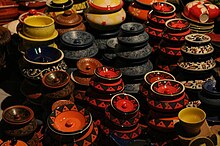Delhi's culture has been influenced by its lengthy history and historic association as the capital of India. This is exemplified by the many monuments of significance found in the city; the Archaeological Survey of India recognises 1200 heritage buildings and 175 monuments in Delhi as national heritage sites. The Old City is the site where the Mughals and the Turkic rulers constructed several architectural marvels like the Jama Masjid (India's largest mosque) and Red Fort. ThreeWorld Heritage Sites—the Red Fort, Qutab Minar and Humayun's Tomb—are located in Delhi. Other monuments include the India Gate, the Jantar Mantar (an 18th-century astronomical observatory) and the Purana Qila (a 16th century fortress). The Laxminarayan Temple, Akshardham, the Bahá'í Lotus Temple and the ISKCON Temple are examples of modern architecture. Raj Ghat and associated memorials houses memorials of Mahatma Gandhi and other notable personalities. New Delhi houses several government buildings and official residences reminiscent of the British colonial architecture. Important structures include the Rashtrapati Bhavan, the Secretariat, Rajpath, the Parliament of India and Vijay Chowk. Safdarjung's Tomb is an example of the Mughal gardens style.
Delhi's association and geographic proximity to the capital, New Delhi, has amplified the importance of national events and holidays. National events like Republic Day,Independence Day and Gandhi Jayanti (Gandhi's birthday) are celebrated with great enthusiasm in Delhi. On India's Independence Day (15 August) the Prime Minister of India addresses the nation from the Red Fort. Most Delhiites celebrate the day by flying kites, which are considered a symbol of freedom. The Republic Day Parade is a large cultural and military parade showcasing India's cultural diversity and military might. Over the centuries Delhi is known for its composite culture, and a festival that symbolizes it truly is the Phool Walon Ki Sair, which takes place each year in September, and where flowers and fans embroidered with flowers, pankha are offered to the shrine of 13th century Sufi saint, Khwaja Bakhtiyar Kaki, along with the Yogmaya Temple also situated in Mehrauli.
Religious festivals include Diwali (the festival of lights), Mahavir Jayanti, Guru Nanak's Birthday, Durga Puja, Holi, Lohri, Chhath, Krishna Janmastami, Maha Shivaratri, Eid ul-Fitr, Moharram and Buddha Jayanti. The Qutub Festival is a cultural event during which performances of musicians and dancers from all over India are showcased at night, with the Qutub Minar as the chosen backdrop of the event. Other events such as Kite Flying Festival, International Mango Festival and Vasant Panchami (the Spring Festival) are held every year in Delhi. The Auto Expo, Asia's largest auto show, is held in Delhi biennially. The World Book Fair, held biannually at the Pragati Maidan, is the second largest exhibition of books in the world with as many as 23 nations participating in the event. Delhi is often regarded as the "Book Capital" of India because of high readership.
Punjabi and Mughlai delicacies like kababs and biryanis are popular in Delhi. The street food there is known to be delicious and includes chaat, golgappe and aloo tikki. Due to Delhi's large cosmopolitan and migrant population, cuisines from every part of India, including Gujarati Rajasthani, Maharashtrian, Bengali,Hyderabadi cuisines, and South Indian food items like idli, sambar and dosa are widely available. Local delicacies include Chaat, Golgappe, Aloo-Tikki and Dahi-Papri. There are several food outlets in Delhi serving international cuisine, including Italian, Japanese, Continental, Middle-Eastern, Thai and Chinese. Within the last decade western fast food has become more popular as well.
Historically, Delhi has always remained an important trading centre in northern India. Old Delhi still contains legacies of its rich Mughal past, which can be found among the old city's tangle of snaking lanes and teeming bazaars. The dingy markets of the Old City have an eclectic product range, from oil-swamped mango, lime and eggplant pickles, candy-colored herbal potions to silver jewelry, bridal attire, uncut material and linen, spices, sweets. Some of old regal havelis (palatial residences) are still there in the Old City. Chandni Chowk, a three-century-old shopping area, is one of the most popular shopping areas in Delhi for jewellery and Zari saris.Notable among Delhi's arts and crafts are the Zardozi (an embroidery done with gold thread) and Meenakari (the art of enameling). Dilli Haat, Hauz Khas, Pragati Maidan offer a variety of Indian handicrafts and handlooms. Over time Delhi has absorbed a multitude of humanity from across the country and has morphed into an amorphous pool of cultural styles.



No comments:
Post a Comment